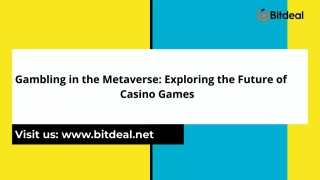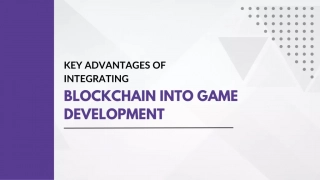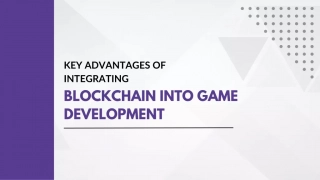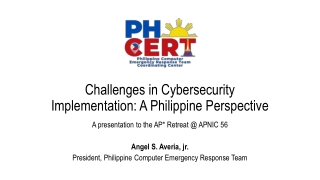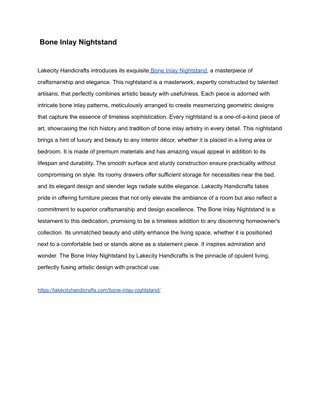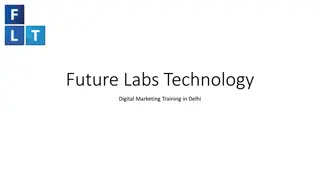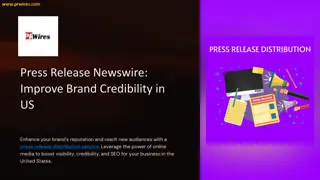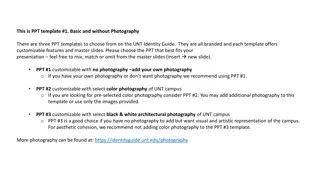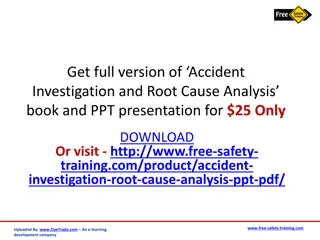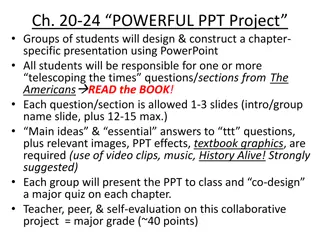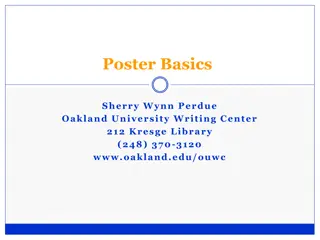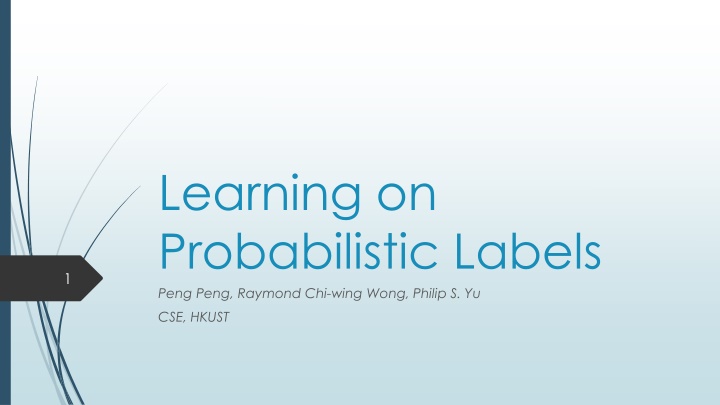
Learning on Probabilistic Labels in Binary Classification
Explore the concept of learning from probabilistic labels in binary classification tasks, where instances are labeled with fractional scores. The approach is motivated by real-world scenarios like crowdsourcing, medical diagnosis, and pattern recognition, where deterministic labels are not readily available. The method aims to learn classifiers from datasets with uncertain labels, providing a valuable tool for handling disagreements among labelers and uncertainties in labeling processes.
Download Presentation

Please find below an Image/Link to download the presentation.
The content on the website is provided AS IS for your information and personal use only. It may not be sold, licensed, or shared on other websites without obtaining consent from the author. If you encounter any issues during the download, it is possible that the publisher has removed the file from their server.
You are allowed to download the files provided on this website for personal or commercial use, subject to the condition that they are used lawfully. All files are the property of their respective owners.
The content on the website is provided AS IS for your information and personal use only. It may not be sold, licensed, or shared on other websites without obtaining consent from the author.
E N D
Presentation Transcript
Learning on Probabilistic Labels Peng Peng, Raymond Chi-wing Wong, Philip S. Yu 1 CSE, HKUST
Outline 2 Introduction Motivation Contributions Related Works Challenges Methodologies Theory Results Experiments Conclusion
Introduction 3 Binary classification: Learn a classifier based on a set of labeled instances Predict the class of an unobserved instance based on the classifier
Introduction 4 Deterministic label: ? Probabilistic Label: ?(? = 1|? = ?).
Introduction 5 Deterministic label: 0 or 1. Probabilistic Label: a real number ? [0,1]. 0 0.3 0 0 1 0 0 0.2 0.7 1 0.6 0 0.1 0.4 1 0.8 1 0.7 0 0.4 0 0.2 1 0.6 1 1 0 0.3 1 0.6 1 0.9
Introduction 6 There are many applications where the instances are labeled with fractional scores. An instance is labeled with multiple labelers and there are disagreements among these labelers. The domain expert cannot give a deterministic label for an instance. The instances themselves are uncertain with a deterministic label.
Introduction 7 We aims at learning a classifier from a training dataset with probabilistic labels. 0.3 0 0.2 0.7 0.6 0.1 0.4 0.8 0.7 0.4 0.2 0.6 1 0.3 0.6 0.9
Motivation 8 In many real scenarios, probabilistic labels are available. Crowdsourcing Medical Diagnosis Pattern Recognition Natural Language Processing
Motivation 9 Crowdsourcing: The labelers may disagree with each other so a determinant label is not accessible but a probabilistic label is available for an instance. Medical Diagnosis: The labels in a medical diagnosis are normally not deterministic. The domain experts (e.g., a doctor) can give a probability that a patient suffers from some diseases. Pattern Recognition: It is sometimes hard to label an image with low resolution (e.g., an astronomical image) .
Contributions 10 We propose a way to learn from a dataset with probabilistic labels. We prove theoretically that compared with learning from deterministic labels, learning from probabilistic labels leads to a faster rate of convergence (i.e., error bound). We give an extensive experimental studies on our proposed method. Significance of our work: our result shows that probabilistic datasets can enhance the performance of many existing learning algorithms if used properly. Besides, a lot of recent studies can use our error bound for their error analysis. Proper Losses for Learning from Partial Labels (NIPS 2012) Estimating Labels from Label Proportions (JMLR 2009) SVM Classifier Estimation from Group Probabilities (ICML 2010)
Related Works 11 Variations of labels in classification: Multiple labels Partial labels Probabilistic labels
Challenges 12 How to learn from a probabilistic dataset ? How to theoretically guarantee that learning from probabilistic labels is more efficient than learning from deterministic labels ?
Methodologies 13 Gaussian Process Regression (GPR) We regard the problem of learning from probabilistic labels as a regression problem. Why GPR ? ? GPR is a hybrid method of statistical learning and Bayesian learning We can simultaneously derive an error bound (based on the statistical learning theory) and obtain an efficient solution (based on the Bayesian method).
Challenges 14 How to learn from a probabilistic dataset ? How to theoretically guarantee that learning from probabilistic labels is more efficient than learning from deterministic labels ?
Methodologies 15 Tsybakov Noise Condition: ? ? = Pr(? = 1|? = ?), i.e., the probability that the instance ? is labeled with 1. ? ? [?,?]. This noise condition describes the relationship between the data density and the distance from a sampled data point to the decision boundary.
Methodologies 16 Tsybakov Noise Condition: Let ? = 0.3. ? ? 1 Pr(? < 0.3) 2 1 ?????? < ? 0.3? 0.5 ? ? 0 0.2 0.8 1
Methodologies 17 Tsybakov Noise Condition: Let ? = 0.4. ? ? 1 Pr(? < 0.4) 2 1 1 ?????? < ? 0.4? 0.9 1 ? ? 0 0.1 0.5
Methodologies 18 Tsybakov noise: The density of the points becomes smaller when the points are close to the decision boundary (i.e., ?(?) is close to 1 2). ? ? 1 ? ? 1 Pr(? < 0.4) Pr(? < 0.3) 2 2 1 1 ?????? < ? 0.4? ?????? < ? 0.3? 0.9 1 ? ? 0.5 0 0.1 ? ? 1 0 0.2 0.8 0.5
Methodologies 19 Tsybakov noise: Given a random instance ?, the probability that E[ ? ? 1 than ? 0.3?; 2] is less than 0.3 is less When ? is larger, the probability is higher so the data is more noisy; when ? is larger, the probability is smaller so the data is less noisy.
Methodologies 20 Strategies: 1. Estimate ?( ) by using the method of Gaussian Process Regression. 2. Given an instance ?, the classifier ? = ? ? ? 0.5. That is, if ?(?) is at least 0.5, we predict 1; otherwise, we predict 0.
Theoretical Results 21 Error bound: Let ?(?) be the excess error of the classifier , which is the difference between the expected error of and the expected error of , where is the optimal classifier achieving the minimum expected error.
Theoretical Results 22 The error bound achieved by our result: ?(? ?+? ? ) Best-known error bound in the realizability setting: ?(? ?) Best-known error bound in the non-realizability setting: ?(? ? ?) Best-known error bound under the Tsybakov noise condition: ?(? ?+? ?+?)
Theoretical Results 23 We have a better result on the rates of convergence (i.e., error bound)! When the order of n is smaller, we have a faster rate of convergence. ?+? the non-realizability setting with deterministic labels. is no greater than 1 2when ? 0, so our error bound is better than that in ? ?+? the realizability setting when ? 2 with deterministic labels. is no greater than 1 when ? 2, so our error bound is better than that in ? ?+? that in the tsybakov noise condition with deterministic labels. Why is our result better? is no greater than ?+1 ?+2when ? 0, so our error bound is always better than ? 1. Intuitively, the probabilistic labels are more informative
Theoretical Results 24 Why is our result better? 2. Normally, the difficulty of solving a classification problem is equivalent to the difficulty of solving a regression problem in the sense of sample complexity. Our key idea is to transform a standard classification problem to a easier regression problem. 3. Theoretically, we can accurately predict the class of an instance even when we do not have an accurate estimation of P(Y=1|X=x) and we only need to guarantee that our prediction of ?(?) falls into the same half interval where P(Y=1|X=x) falls. 4. Based on the noise condition, more instances are observed in the area which is far away from the decision boundary. So, when we have already know that the estimated ?(?) is close to 0 or 1, it is very likely that the estimated ?(?) leads to the true label of ?.
Experiments 25 Datasets: 1sttype: a crowdsourcing dataset (Yahoo!News) 2ndtype: several real datasets for regression 3rdtype: a movie review dataset (IMDb) Setup: A 10-fold cross-validation Measurements: The average accuracy The p-value of paired t-test
Experiments 26 Algorithms for comparison: The traditional method (Trad. Method) The order-based method (OM) The partial method (Partial) The difficult method (Difficult) Our algorithm (FSC)
Experiments 27 The traditional method (Trad. Method): We adopt the standard SVM algorithm (with RBF kernel). Learn a classifier by the idea of margin maximization. The order-based method (OM): This method is based on the paper Learning Classification with Auxiliary Probabilistic Information (ICDM 2011). Maintain the partial order between any two instances (based on the probabilistic information) when learning a classifier. The partial method (Partial): This method is based on the paper Classification with Partial Labels (KDD 2008). Maintain the partial order between any two instances (based on the probabilistic information) when learning a classifier. The difficult method (Difficult) : This method is based on the paper Who Should Label What? Instance Allocation in Multiple Experts Active Learning (SDM 2011). The labeler refuses to label an instance when he or she considers labeling this instance is difficult.
Experiments 28 Yahoo!News Dataset (Business, Politics and Technique) Business vs Politics
Experiments 29 Effect of sample size n on the accuracies of classifiers
Experiments 30 IMDb dataset with the paired t-test: FSC vs OM
Conclusion 31 We propose to learn from probabilistic labels. We prove that learning from probabilistic labels is more efficient than learning from deterministic labels. We give an extensive experimental study on our proposed method.
32 THANK YOU!
Experiments 33 Yahoo!News Dataset Business vs Technique
Experiments 34 Yahoo!News Dataset Politics vs Technique
Experiments 35 Effect of sample size n on the accuracies of classifiers

